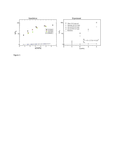Highlight
Rheology of Polymer Nanoparticle Composites
Achievement/Results
Recent advances in nanotechnology have made it possible to design polymeric drug carriers that have the potential to deliver drugs to specific tissues. Currently, one of the challenges in polymeric drug carriers is the formation of thin films for drug delivery. Manufacturing of polymeric thin films is a multi-step process that controls the thickness, width, drug concentration, residual volatiles, mechanical strength, and disintegration rate of therapeutic films. The particle dispersion and viscosity of a precursor are therefore two of the major factors for manufacturing therapeutic films.
Rheological and thermodynamic properties of a precursor are important in manufacturing process for producing films with the well-defined internal structure. Polymer and surfactant adsorption onto API surfaces and depletion interactions affect significantly the process of particle clustering in ternary polymer-solvent-surfactant systems. An undesired phenomenon of polymer-induced particle coagulation may occur, when a surfactant-stabilized dispersion of micro- and nano-particles is mixed with a polymer. Even though PNC have been extensively studied, understanding of the underlying the factors that control viscosity, and dispersion of the particles in the polymer melt is still a challenge.
In this work, a novel approach for determining the shear viscosity and dispersion/agglomeration properties of particle-polymer- composites has been developed by an IGERT research team consisting of Prof. Tomassone and associated students and post docs ((NSF ERC: EEC-0540855; IGERT: DGE-0504497). This work is combines a novel multiscale modeling approach, with both atomistic and mesoscale simulations along with thermodynamics concepts to efficiently represent and study these systems. Their results show a transition from dispersed to agglomerated states when measuring the potential energy and heat capacity in the composite. The viscosity of polymer nanocomposite increases up to 2 orders of magnitude when nanoparticles are included, with respect to the viscosity of a composite made out of micron sized particles. In fact, when nanoparticles are included in the polymer melt, there is a clear break up of the Einstein-Batchelor relationship, which is valid for dilute suspensions (and valid for regular micron sized composites).
In addition to the large enhancement in viscosity, it is observed that nanoparticles form chain bridging with the polymer chains, therefore contributing to the eventual formation of an amorphous solid, typical of these materials. Over the range of shear rates studied, the shear viscosity is strongly dependent on the shear rate. These trends are quantified by a power-law, which has been also verified experimentally. The viscosity of the composite is also sensitive to the size of the filler particles. Decreasing the size of spherical filler particles while keeping the filler volume fraction constant leads to an increase of the viscosity. This has also been observed by other experimental studies.
Address Goals
This activity addresses the primary strategic goal of discovery by focusing on understanding the nano-scale mechanisms that affect viscosity and particle dispersion in polymeric particle nanocomposites. This topic, which is a component of the larger area of polymer rheology, remains one of the great underdeveloped challenges in material science. This activity also addresses the development of research infrastructure in two independent ways, first by generating methods for elucidating the molecular interactions of solid fluid systems at the nano and mesoscale using a coarse grained model, which is of great importance in a myriad of scientific areas in interfacial science, and second by developing methods for characterizing viscosity and particle dispersion. Such methods are of great importance in product development, process optimization, and quality control in many industries that use polymer composites as their main ingredients.







